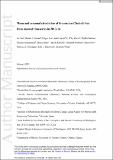| dc.contributor.author | Tian, Fei | |
| dc.contributor.author | Pickart, Robert S. | |
| dc.contributor.author | Lin, Peigen | |
| dc.contributor.author | Pacini, Astrid | |
| dc.contributor.author | Moore, G. W. K. | |
| dc.contributor.author | Stabeno, Phyllis | |
| dc.contributor.author | Weingartner, Thomas | |
| dc.contributor.author | Itoh, Motoyo | |
| dc.contributor.author | Kikuchi, Takashi | |
| dc.contributor.author | Dobbins, Elizabeth | |
| dc.contributor.author | Bell, Shaun | |
| dc.contributor.author | Woodgate, Rebecca A. | |
| dc.contributor.author | Danielson, Seth L. | |
| dc.contributor.author | Wang, Zhaomin | |
| dc.date.accessioned | 2022-02-15T19:05:00Z | |
| dc.date.available | 2022-02-15T19:05:00Z | |
| dc.date.issued | 2021-04-30 | |
| dc.identifier.issn | 2169-9275 | |
| dc.identifier.issn | 2169-9291 | |
| dc.identifier.uri | https://hdl.handle.net/1721.1/140378 | |
| dc.description.abstract | From late-summer 2013 to late-summer 2014, a total of 20 moorings were maintained on the eastern Chukchi Sea shelf as part of five independent field programs. This provided the opportunity to analyze an extensive set of timeseries to obtain a broad view of the mean and seasonally varying hydrography and circulation over the course of the year. Year-long mean bottom temperatures reflected the presence of the strong coastal circulation pathway, while mean bottom salinities were influenced by polynya/lead activity along the coast. The timing of the warm water appearance in spring/summer is linked to advection along the various flow pathways. The timing of the cold water appearance in fall/winter was not reflective of advection nor related to the time of freeze-up. Near the latitude of Barrow Canyon, the cold water was accompanied by freshening. A one-dimensional mixed-layer model demonstrates that wind mixing, due to synoptic storms, overturns the water column resulting in the appearance of the cold water. The loitering pack ice in the region, together with warm southerly winds, melted ice and provided an intermittent source of fresh water that was mixed to depth according to the model. Farther north, the ambient stratification prohibits wind-driven overturning, hence the cold water arrives from the south. The circulation during the warm and cold months of the year is different in both strength and pattern. Our study highlights the multitude of factors involved in setting the seasonal cycle of hydrography and circulation on the Chukchi shelf. | en_US |
| dc.language | en | |
| dc.publisher | American Geophysical Union (AGU) | en_US |
| dc.relation.isversionof | http://dx.doi.org/10.1029/2020jc016863 | en_US |
| dc.rights | Article is made available in accordance with the publisher's policy and may be subject to US copyright law. Please refer to the publisher's site for terms of use. | en_US |
| dc.source | Wiley | en_US |
| dc.title | Mean and Seasonal Circulation of the Eastern Chukchi Sea From Moored Timeseries in 2013–2014 | en_US |
| dc.type | Article | en_US |
| dc.identifier.citation | Tian, F., Pickart, R. S., Lin, P., Pacini, A., Moore, G. W. K., Stabeno, P., et al. (2021). Mean and seasonal circulation of the eastern Chukchi Sea from moored timeseries in 2013–2014. Journal of Geophysical Research: Oceans, 126 | en_US |
| dc.contributor.department | Woods Hole Oceanographic Institution | |
| dc.relation.journal | Journal of Geophysical Research: Oceans | en_US |
| dc.eprint.version | Author's final manuscript | en_US |
| dc.type.uri | http://purl.org/eprint/type/JournalArticle | en_US |
| eprint.status | http://purl.org/eprint/status/PeerReviewed | en_US |
| dspace.date.submission | 2022-02-09T19:58:39Z | |
| mit.journal.volume | 126 | en_US |
| mit.journal.issue | 5 | en_US |
| mit.license | PUBLISHER_POLICY | |
| mit.metadata.status | Authority Work Needed | en_US |
